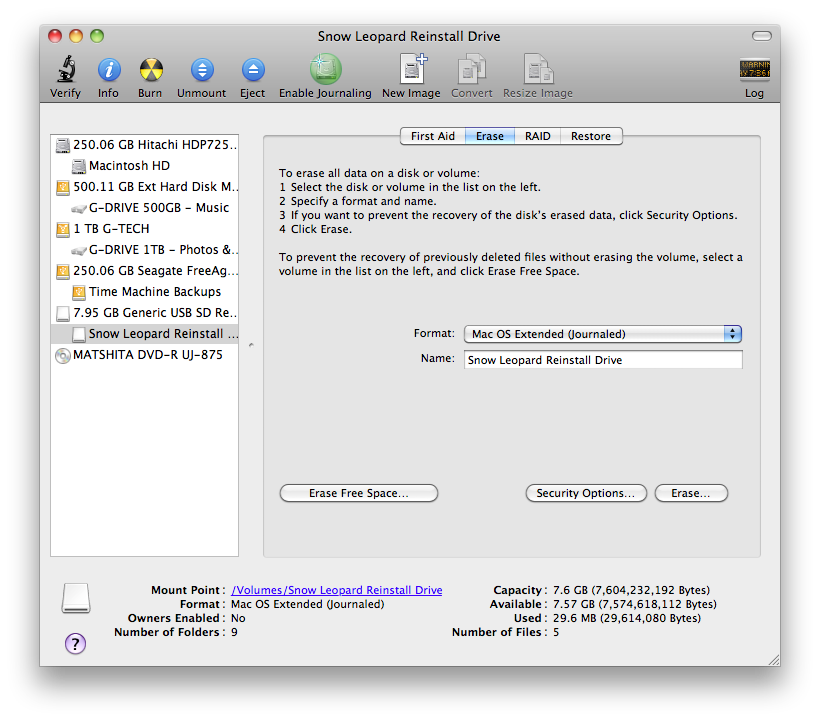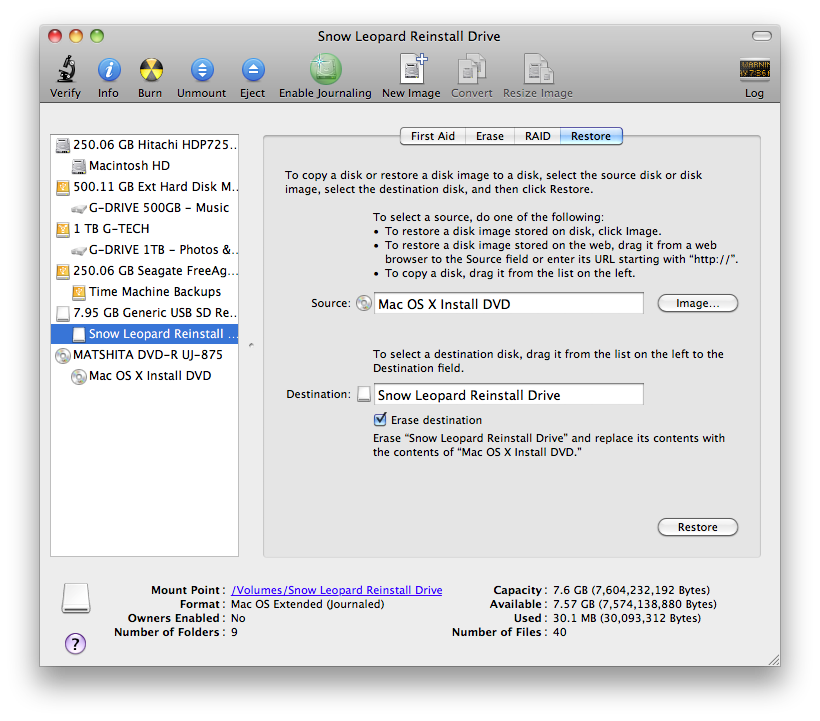The Problem
Recently some of my MacBook hardware failed. The MacBook had sat in a corner unused for a long time. My iPad has come to replace it as my main portable device. Most of what I wanted to do — read the news, email, calendar, magazines — can be done quite easily from my iPad. The MacBook was neglected and somehow it's battery and SuperDrive failed.
I sent it off to a repair shop which confirmed that indeed the MacBook needed a new battery and SuperDrive. I opted to have them replace the battery but not the SuperDrive. I did not use it much. Most of my music and video was stored on another machine and most of my software was bought, downloaded and installed from the Web.
Before sending it off to the repair shop I wanted to remove all the software and data from the hard drive. I wanted to be sure that no one could get access to my sensitive data so I decided to erase the hard drive and re-install Mac OS X. But how to do that with a non-working SuperDrive?
Out of thin Air
The Apple MacBook Air has no optical drive. However, when Apple shipped the latest iteration of their thinnest and lightest notebook computer they included something Apple calls, Software Reinstall Drive. The Software Reinstall Drive is simply a USB flash drive containing the Mac OS X and iLife installation images. Since the MacBook Air has no optical drive, Apple provided this solution so that users could rebuild their system after a hard drive failure. This blog posting is about how to create your own Software Reinstall Drive recovery disk using inexpensive USB flash drives.
Clone install DVD to USB thumb drive using Disk Utility
What we want to do is copy the contents of the OS X install DVD to a USB flash drive. I used a Class 2 SanDisk 8GB micro SDHC card with a tiny case that I bought on Amazon. The case I used is the elago Mobile Nano II USB 2.0 microSDHC Flash Memory Card Reader. The micro SD card slips easily into this very tiny case. For the iLife '11 install disk I used a similar case with 4GB micro SD card. The OS X install image is about 6GB and the iLife 11 image is about 3GB.
A note about microSDHC:
microSD is a format for removable flash memory cards. SD is an abbreviation of Secure Digital. The cards are commonly used in cellular phones, as well as in some newer handheld GPS devices, portable media players, digital audio players, expandable USB flash memory drives, Nintendo DS flashcards, and digital cameras. SDHC (Secure Digital High Capacity, SD 2.0) is an extension of the SD standard which increases the card's storage capacity up to 32 GB.
Creating the Software Install Drive
Open Disk Utility and select the Flash Drive. Select the Erase tab on the right and then set Format to Mac OS Extended (Journaled). Name the partition you’ll be creating Snow Leopard Reinstall Drive or OS X Software Reinstall Drive or anything that you want. Just make sure you name it something that doesn't confuse with your flash drive containing your tax records. After you’ve done this, click the Erase button.

After the flash drive is initialized insert the Snow Leopard install DVD. Select the Restore tab at the top and then drag the Mac OS X Install DVD to the Source field. Drag your USB flash drive to the Destination field. Click Restore and wait for the restoration to complete (about 20 minutes).

Now that the installation files are successfully on your USB device, be sure to eject the Snow Leopard installation DVD from your drive. Eject the USB thumb drive as well.
Using the Software Install Flash Drive
Plug the flash drive into the a Mac and boot the Mac making sure to hold down the option (alt) key on your keyboard. After a few seconds at least two volumes should appear for you to select from for installation. One of those will be the flash drive we just created. Select it and follow the on-screen instructions for installation.
Be patient. USB thumb drives are much slower than hard drives. The installation can take anywhere from 30 minutes to over an hour. I chose Class 2 and Class 4 — the lower the number the slower the memory — SDHC cards to save money but if you have the budget, buy the faster SDHC cards. It will be well worth the extra cost if your time is precious.
After the installation completes, the installer will reboot your computer into your new install of OS X.
What about iLife
To create an installation USB thumb drive for iLife 11' repeat the steps shown here using the iLife DVDs.


